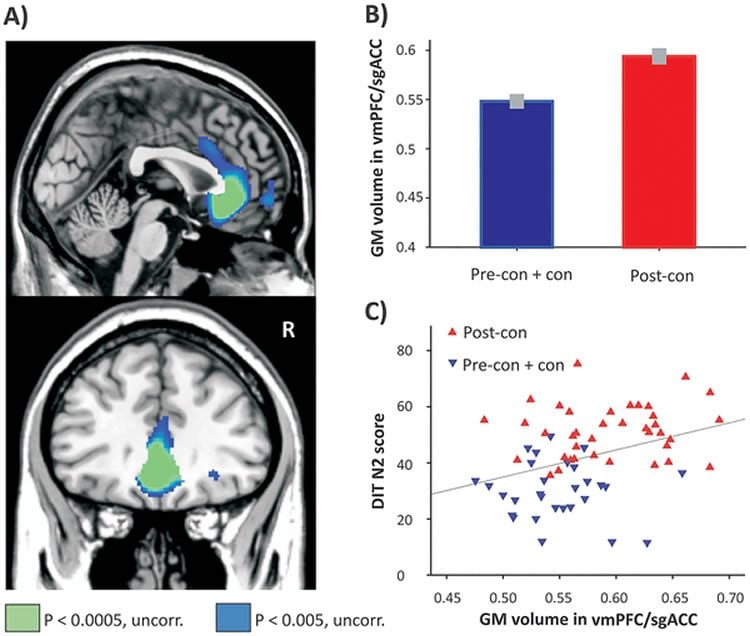Research from Penn scientists and business scholars aims to link moral reasoning with brain architecture.
Individuals with a higher level of moral reasoning skills showed increased gray matter in the areas of the brain implicated in complex social behavior, decision making, and conflict processing as compared to subjects at a lower level of moral reasoning, according to new research from the Perelman School of Medicine and the Wharton School of the University of Pennsylvania in collaboration with a researcher from Charité Universitätsmediz in Berlin, Germany. The team studied students in the Masters of Business Administration (MBA) program at the Wharton School. The work is published in the June 3rd edition of the journal PLOS ONE.
Moral development research pioneered by psychologist Lawrence Kohlberg in the mid-20th century shows that people progress through different stages of moral reasoning as their cognitive abilities mature. Neuroscience has recently reinvigorated moral psychology by introducing new methods for studying moral decision-making. However, no study to date has quantified brain structures supporting individual stages of moral reasoning.
“To investigate this question, we employed a sample of MBA students ages 24 to 33, past the age at which structural brain maturation is complete, and tested their moral reasoning, then looked at the level of gray matter in the brains of a subset of subjects,” said senior author Hengyi Rao, PhD, a research assistant professor of Cognitive Neuroimaging in Neurology and Psychiatry in the Perelman School of Medicine.
“MBA students were ideal candidates for this work, as the Wharton curriculum addresses issues of moral decision-making and reasoning,” explained Diana Robertson, PhD, a professor of legal studies and business ethics at the Wharton School and an author of the study. “We aimed to investigate whether the stage of moral reasoning is reflected in structural brain architecture.”
A total of 67 MBA students were administered the Defining Issue Test to determine which pattern of thought or behavior, known as cognitive schema, each student used when reasoning about moral issues. In it, students were presented with complex moral dilemmas such as medical assisted suicide and asked them to choose the relevance of each of 12 given rationales. Based on the results, subjects were then assigned to one of seven schema types which represent increasing levels of moral development. Students then underwent MRI scanning to investigate differences in gray matter volume between students who reached the post-conventional level of moral reasoning compared to those who have not reached that level yet.

Subjects also underwent personality testing and were placed into one of the following categories: neuroticism, extraversion, openness to experience, conscientiousness, and agreeableness. Analysis showed higher scores in openness to experience and lower scores in neuroticism for participants at the more advanced levels of moral development.
With regard to brain structure, the team observed increased gray matter in the prefrontal cortex in subjects who reached the post-conventional level of moral reasoning compared to those who are still at a pre-conventional and conventional level. In other words, gray matter volume was correlated with the subject’s degree of post-conventional thinking.
“This research adds an investigation of individual differences in moral reasoning to the expanding landscape of moral neuroscience,” Rao said. “The current findings provide initial evidence for brain structural difference based on the stages of moral reasoning proposed by Lawrence Kohlberg decades ago. However, further research will be needed to determine whether these changes are the cause or the effect of higher levels of moral reasoning.”
Source: Lee-Ann Donegan – University of Pennsylvania School of Medicine
Image Credit: The image is credited to Prehn et al./PLOS ONE
Original Research: Full open access research for “Neural Correlates of Post-Conventional Moral Reasoning: A Voxel-Based Morphometry Study” by Kristin Prehn, Marc Korczykowski, Hengyi Rao, Zhuo Fang, John A. Detre, and Diana C. Robertson in PLOS ONE. Published online June 03 2015 doi:10.1371/journal.pone.0122914
Abstract
Neural Correlates of Post-Conventional Moral Reasoning: A Voxel-Based Morphometry Study
Going back to Kohlberg, moral development research affirms that people progress through different stages of moral reasoning as cognitive abilities mature. Individuals at a lower level of moral reasoning judge moral issues mainly based on self-interest (personal interests schema) or based on adherence to laws and rules (maintaining norms schema), whereas individuals at the post-conventional level judge moral issues based on deeper principles and shared ideals. However, the extent to which moral development is reflected in structural brain architecture remains unknown. To investigate this question, we used voxel-based morphometry and examined the brain structure in a sample of 67 Master of Business Administration (MBA) students. Subjects completed the Defining Issues Test (DIT-2) which measures moral development in terms of cognitive schema preference. Results demonstrate that subjects at the post-conventional level of moral reasoning were characterized by increased gray matter volume in the ventromedial prefrontal cortex and subgenual anterior cingulate cortex, compared with subjects at a lower level of moral reasoning. Our findings support an important role for both cognitive and emotional processes in moral reasoning and provide first evidence for individual differences in brain structure according to the stages of moral reasoning first proposed by Kohlberg decades ago.
“Neural Correlates of Post-Conventional Moral Reasoning: A Voxel-Based Morphometry Study” by Kristin Prehn, Marc Korczykowski, Hengyi Rao, Zhuo Fang, John A. Detre, and Diana C. Robertson in PLOS ONE. Published online June 03 2015 doi:10.1371/journal.pone.0122914






